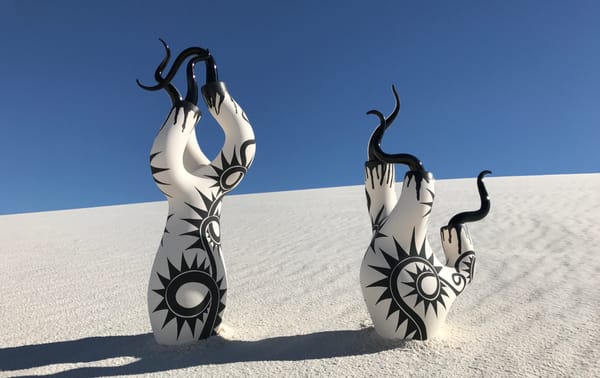Wisdom Testicles and the Messy Process of Collaboration
At first glance, the exterior of Wisdom Testicles, a collection of collaborative works on paper by three artistic schoolmates, looks to be a relatively unassuming artist book. Setting aside its confusing title for a moment, it has the well-crafted and unique appearance of a handmade book. Smallish i
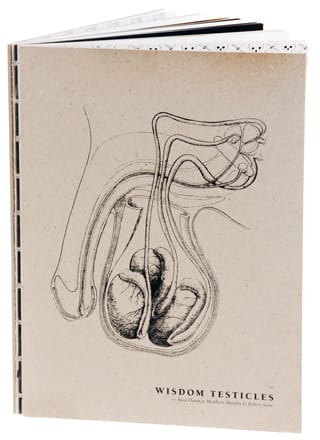
At first glance, the exterior of Wisdom Testicles, a collection of collaborative works on paper by three artistic schoolmates, looks to be a relatively unassuming artist book. Setting aside its confusing title for a moment, it has the well-crafted and unique appearance of a handmade book. Smallish in size and easy to page through, Coptic bound with an open spine, it has raw, unfinished covers made of gray speckled bookboard. The cover of the book, however, on which a anatomical looking drawing of male genitalia has been printed, is provocative enough to immediately dispel any preconceived notions about the book’s modest appearance. The non sequitur nature of the title and cover succeeds in catching your attention, raising a certain amount of curiosity about what lies between the covers.
Though you might not guess it from the cover, limp penis, testes and all, Wisdom Testicles is actually an exhibition catalogue. It documents both the process and the results of a smart collaboration between three artists, Brad Downey, Matthew Murphy and Robert Stone, who met and became “antagonistic” friends while attending London’s renowned Slade School of Art in the early 2000s. Taking over a gallery space in Berlin for an evening, the three young artists stayed up all night in full view of any passerby’s, wishing to highlight both their unique working styles and the messy process of collaboration.
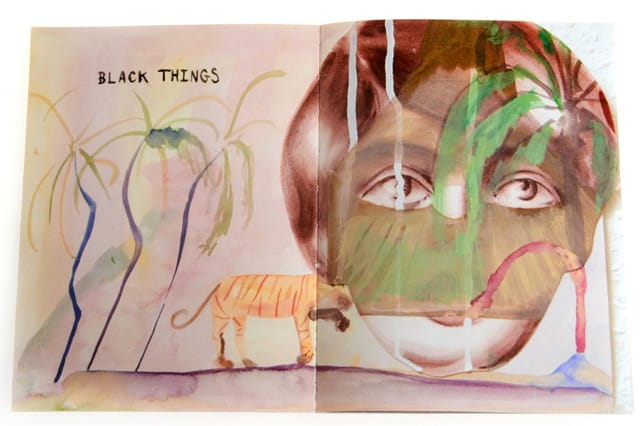
The former classmates also sought to create “entirely new collaborative works” by passing drawings and paintings, many of which were started in advance, back and forth between them throughout the night. The results of the collaboration were then displayed in an exhibition titled, Nothing but Wisdom Testicles. The exhibition consisted mostly of works on paper, a few sculptures, one of them made from crumpled paper and tape that was arranged into a looming, phallic shape, some graffiti-like text and various different wallpapers — an abstracted human skull, a repetitious Jolly Roger drawing, and the male genitals on the book’s cover — were all used to cover the gallery walls.
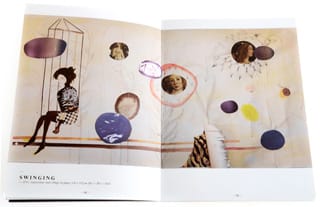
Though the exhibition itself ended up looking more like an artist’s studio ready for a class critique than a gallery installation, it certainly shows how aesthetically illogical the artistic process can be. These artist’s bold aesthetic that emphasizes process over product, diversity of idea rather than a cohesive theme, seems appropriate for this particular collaborative event. As they state in the catalogue, “whatever the results, they’ll be messy and tangible.”
Downey, Murphy and Stone, friends of eight years at the time of their collaboration in 2010, clearly have styles that work well together. Brad Downey, an American artist based in Berlin, is primarily known for his associations with street art, first in a documentary film he made titled Public Discourse, and later for working in tandem with the street artist Darius. His pubic art questions the signs and barriers of our urban environments, and his art is subversive while maintaining a clever sense of humor. His public work, a heart cut into fabric draped over a construction site, or a cement sandcastle made in a broken sidewalk, has a surprisingly Goldsworthy-like feel of impermanent intervention.
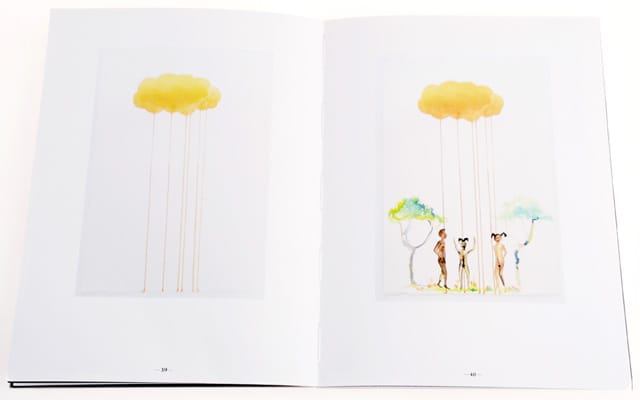
Matthew Murphy, on the other hand, is a figurative painter who works in the whimsical and exaggerated style of portrait painters like John Currin and George Condo. Murphy creates ambiguous portraits of nude women who seem to be elongated, skinny and obscured, covered often by their own hair or wrapped in some inexplicable object that mimics playful, make-believe bondage. Robert Stone, a British painter who shares Murphy’s figurative preferences, is a less realistic draftsman who favors stick figures that feel childishly two-dimensional. His theatrical drawings highlight characters that feel like they are onstage, famed in backgrounds of bright, blurry colors like imaginative illustrations or out of focus memories.
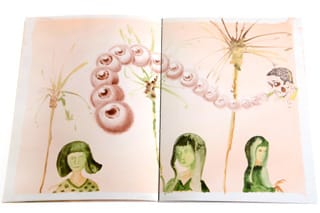
Together, these three artists create drawings and paintings that feel like the moody depictions of a world in which anything nightmarish can happen. They take bits and pieces of real people, animals and landscapes, and place them together on the page or canvas without a sense of order, gravity or realism. The result resembles the drawings you might find in the sketchbook of an adolescent boy, where nudity, sex and violence are the preferred subjects.
Paging through the catalogue eyeballs seem to float, suspended, through most of the paintings like some kind of eerie, disembodied symbol of sight and knowledge; reindeer with human faces are hunted by cowboys with guns; five figures float through the air, engaged in oral sex, next to, rather than on, a lovely spiral staircase; fashionable women are suspended, upside-down by chains, beneath oversized horseshoes; a mustard colored cloud drips a yellow substance onto three stick figures standing beneath it; cat-like animals hang like ornaments from the branches of a brown tree.
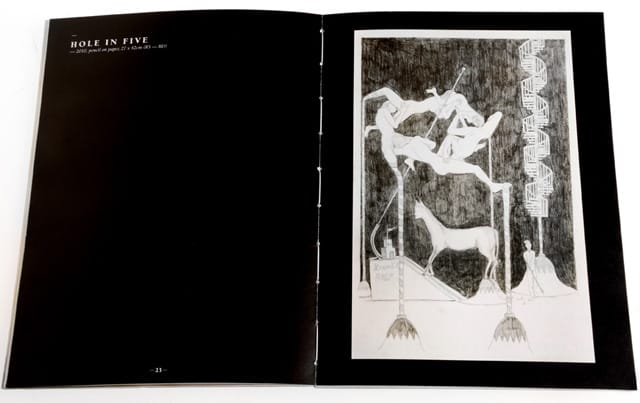
Though many of the pieces shown in Wisdom Testicles have the distinctive mark of one artist in particular, others are so overworked that they become a conglomeration of all three. On a purely aesthetic level it’s hard to suggest that one works better than the other, but certainly the latter is more successful in terms of the artists overall goal of creating a new voice, or one voice, from all three. Wisdom Testicles allows insight into this process by showing us drawings before and after each artist added to them, showing how they changed from sketches to finished pieces. In an unnecessary but thoughtful bit of detail, the catalogue even tells us the order in which each artist worked on a particular piece.
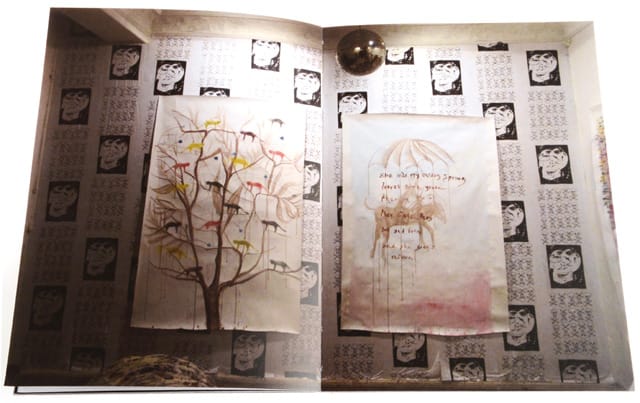
The point of this collaboration, the catalogue seems to suggest, was not necessarily to create “successful” or “finished” works of art, but simply the act of doing it. With the best of artistic intentions Downey, Murphy and Stone crossed their fingers, had fun, and hoped that something worth looking at would come from their night spent locked together in the gallery. Though Wisdom Testicles isn’t a testament to the fact that something worth looking at it did come from it, it is a great endorsement of the value and necessity of trying, at least once in the span of an artistic career, to collaborate with others.
Wisdom Testicles is a limited edition publication (250 copies) by Brad Downey, Matthew Murphy and Robert Stone and published by Verlag Gudberg (2012).




